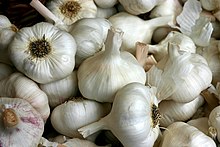Alliin
| Structural formula | |||||||||||||||||||
|---|---|---|---|---|---|---|---|---|---|---|---|---|---|---|---|---|---|---|---|

|
|||||||||||||||||||
| General | |||||||||||||||||||
| Surname | Alliin | ||||||||||||||||||
| other names |
|
||||||||||||||||||
| Molecular formula | C 6 H 11 NO 3 S | ||||||||||||||||||
| Brief description |
odorless, crystalline needles |
||||||||||||||||||
| External identifiers / databases | |||||||||||||||||||
|
|||||||||||||||||||
| properties | |||||||||||||||||||
| Molar mass | 177.23 g mol −1 | ||||||||||||||||||
| Physical state |
firmly |
||||||||||||||||||
| Melting point |
163 ° C (decomposition) |
||||||||||||||||||
| solubility |
soluble in water |
||||||||||||||||||
| safety instructions | |||||||||||||||||||
|
|||||||||||||||||||
| As far as possible and customary, SI units are used. Unless otherwise noted, the data given apply to standard conditions . | |||||||||||||||||||
Alliin is a non-proteinogenic, sulfur-containing amino acid . First described in 1950 by the Swiss chemists A. Stoll and E. Seebeck, Alliin is a natural ingredient in various types of leek , such as wild garlic and especially garlic .
Occurrence
Onions of the leek family contain both alliin and the alliin-splitting enzyme alliinase (Alliin lyase, EC 4.4.1.4 , a sulfenate lyase ), but not in the same cells or cell compartments .
The alliin content in fresh garlic is 0.5 to 1% (or 5 to 14 mg / g), the enzyme reaches values of up to one percent.
Alliin is stored in intact cells in the cytoplasm , whereas alliinase is stored in the vacuoles ; furthermore, in the plant alliin is mainly found in the cells of the mesophyll , while the enzyme is mainly found in the cells surrounding the vascular bundles . If the plant tissue and the cell structure are damaged - for example by eating damage or cutting up - the alliinase and its odorless substrate alliin can come into contact. A chain of chemical reactions is set in motion, during which the cytotoxic (cell-killing) allicin is produced, which is responsible for the typical odor of garlic.


Biological importance
The biological benefit of the alliin-alliinase reaction for the plant is to provide an antibiotic defense system against harmful parasites , microorganisms and certain predators such as insects .
properties
Alliin is chemically derived from the sulfur-containing amino acid cysteine, which is essential for humans , and is a precursor of the pharmacologically active allicin .
As a sulfoxide , the sulfur atom in the alliin is pyramidal and a center of chirality .
literature
- GS Ellmore, RS Feldberg: Allin Lyase Localization in Bundle Sheaths of the Garlic Clove (Allium sativum). In: Am. J. Bot. Vol. 81, No. 1, 1994, pp. 89-94.
- A. Stoll, E. Seebeck: Synthesis of natural alliin. In: Experientia. Vol. 6, No. 9, 1950, p. 330.
- A. Stoll, E. Seebeck: Chemical investigations of alliin, and the specific principle of garlic. In: Adv. Enzymol. Vol. 11, 1951, pp. 377-400.
See also
Individual evidence
- ↑ a b c Entry on Alliin. In: Römpp Online . Georg Thieme Verlag, accessed on June 20, 2014.
- ↑ a b data sheet (+) - L-Alliin at Sigma-Aldrich , accessed on February 12, 2019 ( PDF ).
- ^ Theodor Dingermann, Rudolf Hänsel, Ilse Zündorf (eds.): Pharmaceutical Biology: Molecular Basics and Clinical Applications. 1st edition. Springer Verlag, Berlin 2002, ISBN 3-540-42844-5 , p. 61.
- ↑ S. Ankri, D. Mirelman: Antimicrobial properties of allicin from garlic. In: Microbes Infect. Volume 1, No. 2, 1999, pp. 125-129. PMID 10594976 .

